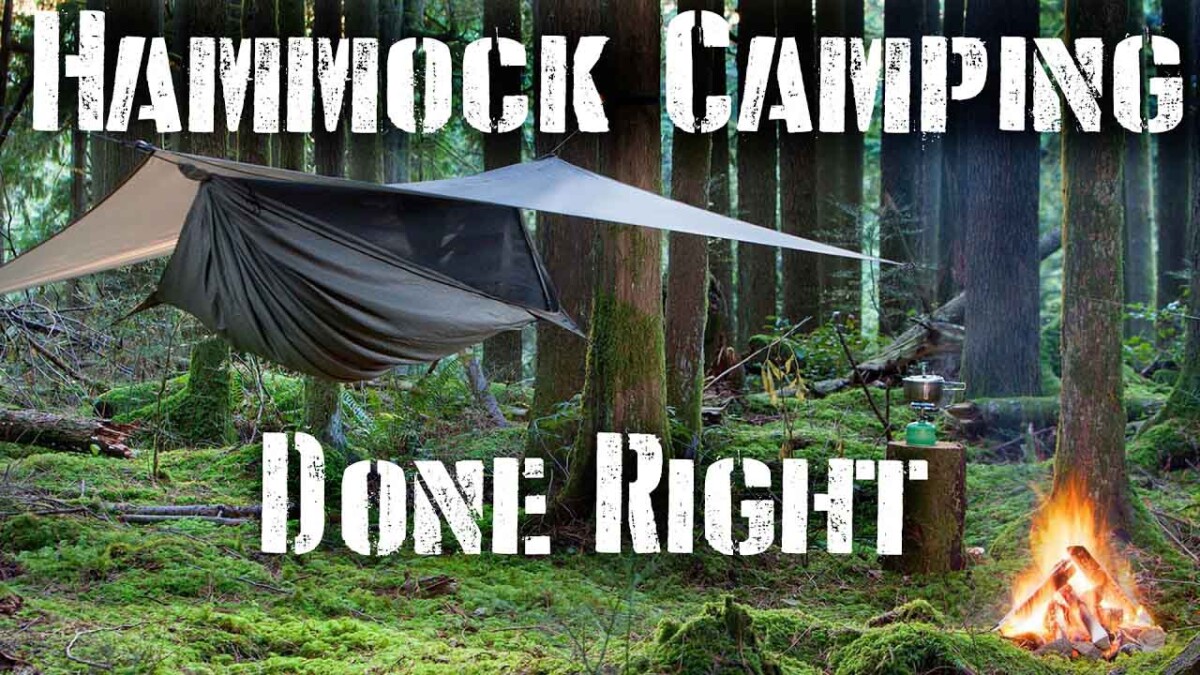If you want to go hammock camping, especially overnight, you will need much more than a hammock. A single hammock on its own can be enough if you just want to go out and have a good time for a few hours, or if it is super warm out, but during most of the year you are going to freeze your butt off if you take nothing but a nylon hammock. However there are a few things you can take that will make your experience much better. Here I will go over exactly what you need to take with you to stay warm and protected overnight in your hammock.
1 | Hammocks
To start off, we obviously need to get a hammock. There is nothing wrong with your basic nylon hammock that you can find anywhere. They are durable and relatively cheap when compared to other hammocks. Personally I use a single nest nylon hammock made by ENO. It works well for just about any situation, but if i could go back I would definitely buy the double hammock instead just to have a bit more room.
The main problem with nylon hammocks is how thin they are. They are paper thin, and that is going to allow the elements to go right through it. While these nylon hammocks work great at being a hammock, they are terrible for keeping you warm. There are a few other hammocks on the market that are made to keep you warm, but they can get quite expensive. However, there are a few other things on this list that will make sure you stay warm, so all in all, a simple nylon hammock is a great choice for all hammock campers, especially beginners.
2 | Hammock Straps/Suspension System

The next thing you need to have are hammock straps. Normally you can pick up a nice set of these for about $20. I highly suggest investing in some of these straps. They are leaps and bounds better than using paracord or other rope products. To start off, these straps are super easy to set up and use, plus I have never had one slip from a tree. Secondly, they are much more durable. Paracord stretches overtime when it is under stress. So when you wake up in the morning, do not be surprised if your hammock is nearly touching the ground.
3 | Sleeping Bag
Next, a sleeping bag is a must have during colder weather. If you can get into a sleeping bag while in your hammock, you will be much warmer and more comfortable than ever. I know that when I get my whole camp set up and then climb into my sleeping bag and hammock, I never want to leave. Plus your basic sleeping bag will do the trick, no need to get super fancy here.
4 | Under Quilt
An under quilt will be what keeps you the warmest while out hammock camping. An underquilt connects to the ends of your hammock and hangs “under” your hammock. Which sort of makes it like a second, fluffier hammock. Although it is not designed to hold body weight, it is designed to keep you warm. It is the main barrier between the cold wind and your back, plus some models are even made to act like a pod system and zip up over you if you prefer. Even with a sleeping bag, an underquilt can make all the difference when it is cold out. I actually made an entire video about my favorite underquilt and I am also giving one away, so check that out here.
Although when you are setting up your under quilt, always make sure to hang it a few inches below your hammock. That way you can get a few inches of air between it and your hammock. This creates an insulating barrier that will keep you warmer than if you just cinched it up to your hammock.
5 | Hammock Tarp

One crucial piece of equipment is a hammock tarp. Obviously a tarp is good for keeping rain and other debris off of you throughout the night but it can also help you stay insulated. You should set it up in a tipi or tent shape, and keep it close to you. Setting it up super high may work to keep rain off you, but you are missing out on the opportunity to insulate. Setting it up close to you, about 3ish feet higher than the hammock, will capture some of the hot air that comes off your body and keep it close to you for a longer period of time.
Personally, I use the Hennessy Hammock Tarp. It has worked well for me in the past and my favorite thing about it is that it comes with built-in strings in each corner so I do not have to worry about packing something to set it up with. All I have to do is unpack it and tie it to the tree with a double hitch knot and it is ready to go.
6| Bug Netting
One last thing that you should consider depending on your location and time of year is a bug net. I love the outdoors, but I hate mosquitoes. A bug net will keep all those pesky insects away, and I definitely suggest a bug net if you are setting up close to water.
Bug nets are not very expensive and millions of people die every year around the world from illnesses acquired from bug bites, so it is better safe than sorry.
Conclusion
To wrap it all up, when you are going out into the outdoors to hammock camp, make sure you pack more than a hammock. While a basic nylon hammock will do the trick for many situations, you want to make sure you bring a sleeping bag as well as an underquilt to keep you warm through the night. You will also not regret buying a set of hammock straps to set everything up with. Lastly, use a tarp to keep the rain and dew off you and to insulate you a tad bit more, for added protection include a bug net into your set up. With all of these things combined, you will be more comfortable in your hammock than your own bed.
Recent Posts
So 2020 was a rough year. We saw massive hurricanes, including one spot in the Gulf Coast that was stuck by two different hurricanes mere days from one another. We also witnessed one of the...
When many people get into prepping, they commonly focus on fantasies about the end of the world and building a bug-out bag to help prepare them. But the truth is these scenarios only come...

